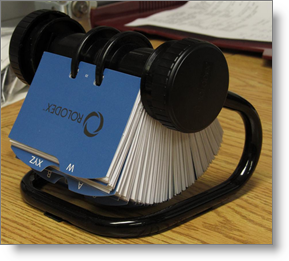
David is the consummate networker who has also had a terrific career. He’s a grandpa living in Utah and just recently was the CEO of HireVue, and before that, CEO of the amazing Fusion-IO. He is active on social media and has a big, giving heart.
Back to the “contact manager” concept. In the olden days (well, actually, even today) most people had not heard of a “contact manager.” Everyone had heard of a Roladex, which is an old-fashioned device that sat on your desk, and allowed you to quickly flip through cards that had your contacts’ information on them so you could find their phone number and call them. Here’s a modern-looking roladex (image courtesy wikipedia):
According to what I’ve found online, ACT! was the first digital contact manager – that is, a contact manager on a computer. It was 1986 (where were YOU in 1986??) and ACT! would be the first of hundreds. There were a few others that you probably haven’t heard of, the one I briefly used was Goldmine. Today you have likely heard of the massive $5B/annual company Salesforce.com. Perhaps there are thousands of CRM systems now.
CRM stands for Customer Relationship Management… and this software has mostly been designed for sales professionals. Some of them LOVE the software, and live-and-die on CRM, and others abhor CRM (because they are people people, and not software nerds).
The Roladex, and the little black book of contacts, were for anyone trying to keep track of their friend/family, etc.
CRM was really mostly for salespeople. Who else would pay that much for software that was that hard to use, when all you really wanted was a place to write down a phone number?
When David wrote about using a “contact manager” in his book, I got excited. He is not using it as a sales professional, he’s using it as a real contact manager! He’s using it to keep track of who is is meeting, what their important phone information is, when he communicates with them, and when he needs to follow-up.
Let me break that down, and make this a “how to” post. This is more of a “how to get value out of a contact manager” than how to use any bells and whistles. And just for fun, I’m going to use “JibberJobber” instead of “contact manager.”
First, store your contacts in JibberJobber.
You can store all of them, but you don’t need to. Don’t get stressed that one system (perhaps your email contact list) has contacts that are not in JibberJobber, or that LinkedIn doesn’t have all of the same contacts as you have in JibberJobber. Recognize that these are different systems with different purposes. The purpose of your contact manager (JibberJobber) is not to have the contacts everwhere else, but to serve as a central repository of IMPORTANT contacts that you are, can or want to nurture. If someone comes into your life through LinkedIn, eventually they’ll probably end up in JibberJobber.
Second, record information about those contacts.
When you first enter a contact, you likely won’t have all of the information you could put in about them. I usually start with just the first name, last name, and email address. As my relationship progresses, or as we exchange more and more emails, I will find out other information, like a work address or phone number, which might be in their official work email. Just collect this information as you get it, and gradually enter it into JibberJobber. Don’t stress about not having it to begin with…
Third, record important communication as “log entries.”
When you reach out to someone, or respond to them, log it into JibberJobber. I don’t do this all the time, but as I’m starting a relationship I’ll log any communication just to put a timeframe around how fast or slow our relationship is forming. Once I have a strong relationship with someone, I find myself logging communications less, but the quality of what I’m logging increases. For example, we meet at a networking event and I send you an email. I’ll log that email, even though it’s not going to have anything more substantial than “nice to meet you – let’s get on a call next week.” A few years later I’m not going to log every email we exchange, but if there is something big, or important, then I’ll log that. Don’t beat yourself up for not logging everything… you’ll get used to what you really want to track and what you don’t need to.
Fourth, indicate when you need to follow-up with your contacts.
This might be one of the hardest things to do, and track, for people who are starting to get serious about networking. Why? Because the more you network, the more follow-up you can do! And it feels rotten to meet people, start a relationship, and then forget when to follow-up, or who they were, or why you should follow-up, etc. In JibberJobber, you’ll create “action items,” which is basically a due date on a log entry. You can even create recurring action items, which means you can say “Ping Johnny every quarter,” to help you nurture relationships over the long-term.
Keith Ferrazzi says that if you want to be better than 95% of your competition, all you have to do is follow-up. We know this, but there’s a reason why 95 out of 100 people don’t do it: it’s hard to manage!
Let JibberJobber be your contact manager and your follow-up tool.
The focus is not on sales, rather on relationships.
Are you ready to get serious about this yet? Jump on a User Orientation webinar, and let’s start by taking baby steps together.

